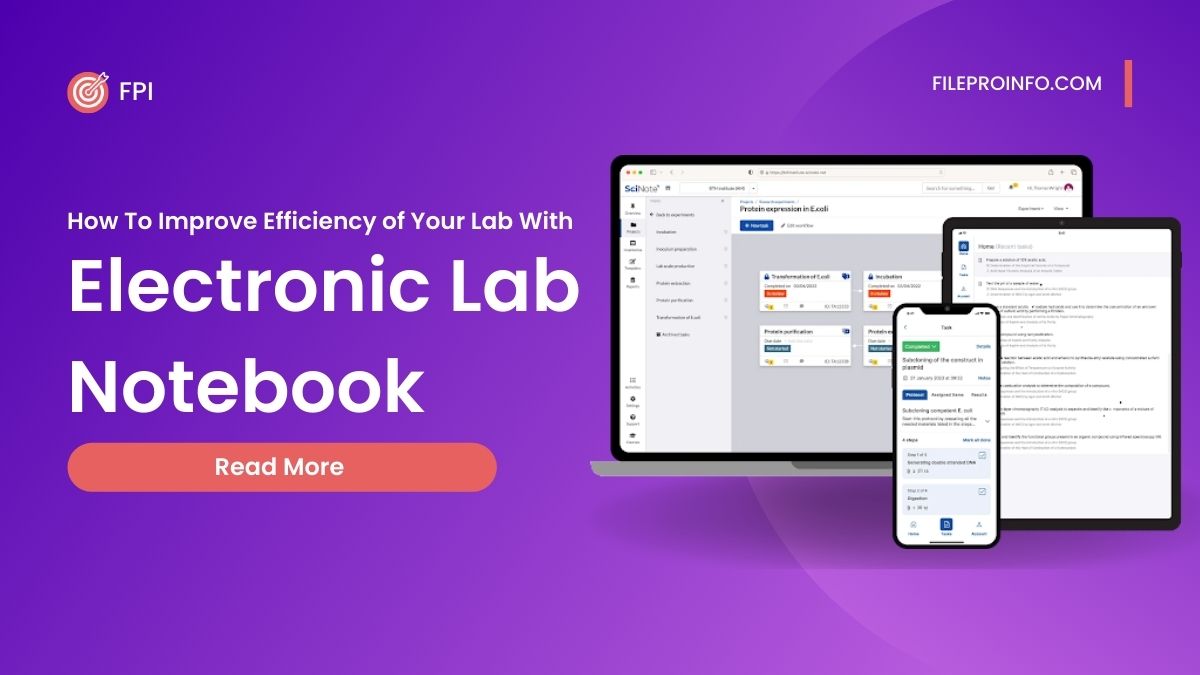
In the ever-evolving landscape of scientific research, laboratories are constantly seeking ways to enhance efficiency, streamline workflows, and improve data management. One powerful tool that has gained widespread adoption in recent years is the Electronic Lab Notebook (ELN). This digital solution offers a myriad of advantages over traditional paper-based notebooks, ranging from enhanced collaboration to simplified data organization.
In this article, we will explore the key ways in which adopting an Electronic Lab Notebook can significantly boost the efficiency of your laboratory.
Enhanced Data Accessibility and Organization
Electronic Lab Notebooks (ELNs) centralize experimental data, providing a searchable database with keyword tagging. This ensures quick access to information, streamlines data retrieval, and promotes efficient organization in laboratories.
- Centralized Data Repository: One of the primary advantages of an Electronic Lab Notebook is the ability to centralize all experimental data in a digital repository. Unlike traditional notebooks, where information might be scattered across multiple physical volumes, Electronic Lab Notebook (ELN) Software provides a centralized and easily searchable database. This not only saves time in locating specific data but also ensures that all team members have access to the latest information in real-time.
- Keyword Search and Tagging: ELNs typically come equipped with robust search functionalities, allowing researchers to quickly locate specific experiments, protocols, or data points. Additionally, the ability to tag entries with keywords enhances organization and simplifies the retrieval of relevant information. This feature is particularly beneficial when dealing with large datasets or when revisiting past experiments for reference.
Improved Collaboration and Communication
ELNs enable real-time collaboration, allowing researchers to contribute simultaneously, share insights, and coordinate activities. Integration with communication tools enhances communication efficiency, fostering a dynamic and collaborative research environment.
- Real-Time Collaboration: Traditional lab notebooks often involve a linear and solitary process of note-taking. In contrast, ELNs facilitate real-time collaboration among team members, regardless of their physical location. Researchers can simultaneously contribute to a project, share insights, and provide feedback, fostering a more dynamic and collaborative research environment.
- Secure Data Sharing: ELNs offer a secure platform for sharing data and insights with collaborators, both within and outside the laboratory. With granular access controls, researchers can determine who has permission to view or edit specific entries. This not only enhances security but also streamlines the exchange of information, especially in multi-disciplinary research projects involving researchers from different institutions.
- Integration with Communication Tools: Many ELNs integrate seamlessly with communication tools such as Slack or Microsoft Teams. This integration enables researchers to discuss findings, share updates, and coordinate activities directly within the ELN platform. Such integration reduces the need to switch between different applications, resulting in a more efficient and streamlined communication process.
Facilitated Compliance and Documentation
ELNs offer electronic signatures, audit trails, and automated record-keeping, ensuring compliance with regulations. These features enhance accountability, providing secure and traceable documentation of experiment approvals, authorizations, and changes.
- Electronic Signatures and Audit Trails: In regulated industries, maintaining compliance with various standards and regulations is paramount. ELNs often come equipped with electronic signature capabilities, providing a secure and traceable method for documenting experiment approvals and authorizations. Audit trails further enhance accountability by recording all changes made to entries, ensuring a transparent record of the experimental process.

- Automated Record-Keeping: ELNs can automate the recording of experimental details, reducing the likelihood of errors associated with manual data entry. Timestamps, version control, and automated backups contribute to accurate and comprehensive record-keeping. This automation not only saves time but also minimizes the risk of data discrepancies, a crucial aspect of maintaining the integrity of scientific research.
Efficient Experiment Planning and Reproducibility
ELNs provide template-based experiment design, standardizing protocols, and facilitating reproducibility. Integration with laboratory instruments enables direct data transfer, reducing manual entry errors and accelerating the experimental process.
- Template-Based Experiment Design: ELNs often provide templates for experiment design, allowing researchers to standardize protocols and procedures. This not only streamlines the planning phase but also contributes to the reproducibility of experiments. Templates ensure that key parameters are consistently recorded, making it easier for researchers to replicate experiments accurately.
- Integration with Laboratory Instruments: Many ELNs can integrate with laboratory instruments, allowing for direct data transfer from devices to the digital notebook. This integration eliminates the need for manual data entry, reducing the risk of transcription errors and accelerating the experimental process. Real-time data streaming from instruments to the ELN enhances the efficiency of data capture and analysis.
Cost and Resource Optimization
Transitioning to ELNs reduces paper usage, contributing to environmental sustainability and cost savings. The digital platform increases productivity, saves time spent on manual tasks, and aligns with the growing emphasis on sustainable research practices.
- Reduced Paper Usage: The transition from paper-based notebooks to ELNs contributes to environmental sustainability by significantly reducing paper usage. Beyond the environmental benefits, this shift also translates into cost savings associated with purchasing and storing physical notebooks. ELNs offer a more eco-friendly and cost-effective alternative, aligning with the growing emphasis on sustainable research practices.
- Time Savings and Increased Productivity: The cumulative impact of the aforementioned benefits of ELNs is a notable increase in overall lab productivity. Time spent searching for information, coordinating with team members, and manually documenting experiments is significantly reduced. Researchers can redirect this saved time towards more critical tasks, such as data analysis, experimental design, and innovation.
Overcoming Challenges and Ensuring Successful Implementation
- User Training and Adoption: While the benefits of ELNs are substantial, successful implementation requires adequate user training and adoption strategies. Providing comprehensive training sessions and support during the transition phase is crucial in ensuring that researchers feel comfortable and confident using the new digital platform.
- Data Security and Compliance Considerations: When adopting ELNs, laboratories must prioritize data security and compliance with relevant regulations. Implementing robust access controls, encryption protocols, and regular security audits will help safeguard sensitive research data. Additionally, ensuring that the chosen ELN solution complies with industry-specific standards is essential for maintaining the integrity of research outcomes.
- Customization for Specific Research Needs: Different research laboratories may have unique requirements based on their areas of study. Choosing an ELN that allows for customization to accommodate specific research needs is vital. Whether it’s adapting templates, integrating with specialized instruments, or tailoring data fields, the flexibility of the ELN platform plays a key role in its effectiveness within a particular research context.
Summing Up
The adoption of Electronic Lab Notebooks represents a significant leap forward in enhancing the efficiency of laboratory operations. From streamlined data management to improved collaboration and compliance, ELNs offer a comprehensive solution for modern research challenges. Embracing this digital transformation not only future-proofs laboratories but also contributes to a more sustainable and agile research environment. As technology continues to advance, the integration of innovative tools like ELNs will undoubtedly play a pivotal role in shaping the future of scientific discovery.




